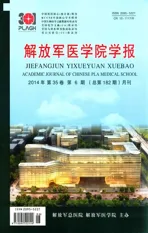串珠素小干扰RNA对结直肠癌细胞增殖的影响
2014-04-20刘洪金赵忠鹏杨鹏辉段跃强王希良
刘洪金,赵忠鹏,付 艳,杨鹏辉,段跃强,门 丽,赵 晖,杜 楠,王希良
1解放军总医院第一附属医院 肿瘤二科,北京 100048;2军事医学科学院 微生物流行病研究所,北京 100071
串珠素小干扰RNA对结直肠癌细胞增殖的影响
刘洪金1,赵忠鹏2,付 艳1,杨鹏辉2,段跃强2,门 丽2,赵 晖1,杜 楠1,王希良2
1解放军总医院第一附属医院 肿瘤二科,北京 100048;2军事医学科学院 微生物流行病研究所,北京 100071
目的评估串珠素小干扰RNA(siRNA)对肿瘤细胞增殖的影响。方法体外培养HCT15和HT29结直肠癌细胞,将构建好的串珠素siRNA载体转染培养细胞中,荧光显微镜下观察转染效率,qRT-PCR法检测串珠素mRNA表达,Western blot法检测串珠素蛋白表达,MTS法检测串珠素siRNA对肿瘤细胞增殖的影响。结果串珠素siRNA转染肿瘤细胞48 h后,肿瘤细胞串珠素mRNA、蛋白水平均出现降低(P<0.05)。串珠素siRNA对肿瘤细胞增殖有明显的抑制作用(P<0.01)。结论串珠素siRNA对结直肠癌肿瘤细胞增殖具有显著的抑制效果。
结直肠癌;HCT15;HT29;串珠素;siRNA
结直肠癌是发病率较高的消化道肿瘤,发病趋势呈现年轻化,与饮食习惯、生活环境等因素相关[1-2]。结直肠癌往往具有较高的侵袭性,以血管转移常见;转移性结直肠癌具有较差的预后[3-4]。串珠素是一种硫酸肝素糖蛋白,它广泛表达于多种侵袭性肿瘤,比如结直肠癌和恶性黑色素瘤[5]。文献表明串珠素参与肿瘤生长、侵袭和肿瘤血管新生;串珠素在肿瘤血管侵袭中起着重要作用[6-7]。本实验主要在体外结直肠癌细胞系上检测串珠素siRNA对肿瘤细胞增殖的影响,为串珠素靶点药物治疗结直肠癌提供一些参考。
材料和方法
1 材料 HCT15和HT29细胞株购于中国科学院上海生命科学研究院细胞资源中心。DMEM培养基、IMDM培养基、胎牛血清、0.25%胰蛋白酶均购于美国Hyclone公司。抗人串珠素抗体、抗人β-actin抗体和羊抗兔抗体(二抗)购自美国Cell signaling technology公司。串珠素siRNA序列据文献合成,由美国Invitrogen公司合成,序列如下:5-GUUGGAGCAGCGGACAUAUTT-3-(sense)和3-TTCAACCUCGUCGCCUGUAUA-5-(anti-sense),电泳并测序鉴定[8]。退火后与pRNAT-U6.1/Neo载体(含绿色荧光)相连接。
2 细胞培养 HCT15细胞株培养于含10%胎牛血清的IMDM培养基中,HT29细胞株培养于含10%胎牛血清的DMEM培养基。放置于37℃、5% CO2的培养箱中,1 ~ 2 d换液1次,待贴壁细胞长满至80% ~ 90%时传代。当细胞达到对数生长期的时开始进行细胞试验。
3 转染 先将对数生长期的细胞以5×105/孔铺于六孔培养板,待细胞长满至90%时更换为无血清培养基,4 h后采用Lipofectamine 2000转染试剂进行转染。转染48 h后PBS冲洗,收集细胞进行后续试验检测转染效率。
4 Western blot 转染后48 h收集细胞,提取蛋白,BCA法进行蛋白定量,采用3% ~ 8%梯度聚丙烯酰胺凝胶(Invitrogen公司),上样,电泳,采用PVDF膜转膜,封闭慢摇床,浸入稀释的一抗中(1∶500),于摇床上4℃杂交过夜,TBST洗膜3遍。取出PVDF膜,洗膜后孵育二抗(1∶5 000),摇床上杂交1 h。取出PVDF膜,TBST洗膜3遍。将ECL试剂盒内的两种试剂等体积混合后滴在PVDF膜上,反应1 ~ 2 min,然后在暗屋中压X线片45 min后曝光,分析结果。
5 实时定量PCR 引物序列如下:串珠素:forward primer TGGCTGACAGCATCTCAGGA,reverse primer CGATGGAGCGAGTGAAATTCA,probe (5_FAM) ACTTCCAGATGGTTTATTTCCGAGCCCTG (3_ TAMRA)。β-actin:forward primer TGAGCGCG GCTACAGCTT,reverse primer TCCTTAATGTCACG CACGATTT,probe (5_FAM)-ACCACCACGGCCGAG CGG-(3_TAMRA)。引物合成于生工生物工程(上海)有限公司。收集细胞,采用Triozl法提取RNA,AMV法逆转录合成cDNA,在ABI7500荧光定量PCR仪上进行qRT-PCR。串珠素mRNA表达水平用内参β-actin水平来校对。
6 MTS法检测细胞增殖能力 肿瘤细胞生长密度为70% ~ 80%时,96孔板细胞铺板,20 000/孔,置于37℃温箱。24 h后换为新鲜血清培养基,同时加入串珠素siRNA试剂及转染试剂。48 h后加入MTS试剂(Promega公司),37℃温箱中放置2 h后置于酶标仪,检测490 nm波长每孔的吸光度,绘制肿瘤细胞生长曲线。
7 统计学处理 采用SPSS15.0软件进行数据统计分析,数据用±s表示,采用单因素t检验,P<0.05为差异有统计学意义。
结 果
1 转染后荧光显微镜下观察 串珠素siRNA转染肿瘤细胞后,肿瘤细胞出现绿色荧光并逐渐增多,转染48 h后,细胞转染效率最高,可达70%以上,而空白对照组始终未见绿色荧光。见图1。
2 实时定量 PCR测定转染48 h后,和空白对照组及阴性对照组相比,siRNA组串珠素mRNA表达水平出现了明显的降低。见图2。

图 2 实时定量PCR检测串珠素的mRNA水平表达 A: HCT15细胞; B: HT29细胞Fig. 2 RT-PCR showing expression of perlecan mRNA in HCT15 cells (A) and HT29 cells (B) (aP<0.05, vs group C)
3 Western blot法测定 转染48 h后,和空白对照组相比,siRNA组的串珠素蛋白表达水平出现了明显的降低。见图3。

图 1 转染后48 h肿瘤细胞绿色荧光蛋白的表达 A:转染siRNA的HCT15细胞(×200); B: HCT15细胞空白对照组(×200); C:转染siRNA的HT29细胞(×200); D: HT29细胞空白对照组(×200)Fig. 1 Expression of green fl uorescent protein in HCT15 cells (A), blank control HCT15 cells (B), and HT29 cells 48 h after transfected with perlecan siRNA (×200)
4 串珠素siRNA对结直肠癌细胞增殖的影响转染48 h后,和空白对照组及阴性对照组相比,siRNA组肿瘤细胞增殖明显受到抑制。见图4。

图 3 Western blot法检测两种肿瘤细胞的串珠素蛋白表达情况 A: HCT15空白对照组;B: HCT15 siRNA组;C: HT29 空白对照组;D:HT29 siRNA组Fig. 3 Western blot showing expression of perlecan HCT15 control group (A), HCT15 siRNA group (B), HT29 control group (C) and HT29 siRNA group (D)

图 4 加入串珠素siRNA 48 h后,HCT15和HT29细胞增殖图A: HCT15细胞; B: HT29细胞Fig. 4 Growth curves of HCT15 cells (A) and HT29 cells (B) 48 h after exposed to perlecan siRNA(bP<0.01, vs group C)
讨 论
串珠素是细胞胞外基质的主要成分,也分布于细胞膜表面及基底膜[8-9]。它与各种生长因子关系密切,在肿瘤生长、侵袭和肿瘤血管新生中起着重要的作用[10-12]。文献表明转移性结直肠癌表达高水平的串珠素;低转移肿瘤往往表达低水平的串珠素[11-13]。动物实验表明串珠素促进肿瘤生长和肿瘤血管新生[13]。因此串珠素是转移性结直肠癌治疗中一个潜在的药物靶点[14-15]。
本实验表明串珠素siRNA对结直肠癌细胞增殖具有显著的抑制作用,串珠素的低表达导致了肿瘤细胞增殖的抑制,这表明串珠素是结直肠癌治疗的常规药物靶点。串珠素在肿瘤血管生成中发挥着重要作用,因此串珠素也是抑制肿瘤血管新生的肿瘤治疗药物靶点[3,16]。本实验为结直肠癌治疗提供一个药物靶点,也为串珠素靶点的药物治疗提供一些参考[17-18]。
1 Hurwitz H, Fehrenbacher L, Novotny W, et al. Bevacizumab plus irinotecan, fluorouracil, and leucovorin for metastatic colorectal cancer[J]. N Engl J Med, 2004, 350(23):2335-2342.
2 Schultheis B, Folprecht G, Kuhlmann J, et al. Regorafenib in combination with FOLFOX or FOLFIRI as first- or second-line treatment of colorectal cancer: results of a multicenter, phase Ib study[J]. Ann Oncol, 2013, 24(6):1560-1567.
3 Koutras AK, Starakis I, Kyriakopoulou U, et al. Targeted therapy in colorectal Cancer: current status and future challenges[J]. Curr Med Chem, 2011, 18(11): 1599-1612.
4 Zoratto F, Rossi L, Zullo A, et al. Critical appraisal of bevacizumab in the treatment of metastatic colorectal Cancer[J]. Onco Targets Ther, 2012, 5: 199-211.
5 Cohen IR, Murdoch AD, Naso MF, et al. Abnormal expression of perlecan proteoglycan in metastatic melanomas[J]. Cancer Res,1994, 54(22): 5771-5774.
6 Ahsan MS, Yamazaki M, Maruyama S, et al. Differential expression of perlecan receptors, α-dystroglycan and integrin β1, before and after invasion of oral squamous cell carcinoma[J]. J Oral Pathol Med, 2011, 40(7): 552-559.
7 Zhou Z, Wang J, Cao R, et al. Impaired angiogenesis, delayed wound healing and retarded tumor growth in perlecan heparan sulfatedeficient mice[J]. Cancer Res, 2004, 64(14): 4699-4702.
8 Tsuneki M, Cheng J, Maruyama S, et al. Perlecan-rich epithelial linings as a background of proliferative potentials of keratocystic odontogenic tumor[J]. J Oral Pathol Med, 2008, 37(5): 287-293.
9 Ishijima M, Suzuki N, Hozumi K, et al. Perlecan modulates VEGF signaling and is essential for vascularization in endochondral bone formation[J]. Matrix Biol, 2012, 31(4): 234-245.
10 Sakai K, Nakamura T, Matsumoto K, et al. Angioinhibitory action of NK4 involves impaired extracellular assembly of fibronectin mediated by perlecan-NK4 association[J]. J Biol Chem, 2009, 284(33):22491-22499.
11 Whitelock JM, Melrose J, Iozzo RV. Diverse cell signaling events modulated by perlecan[J]. Biochemistry, 2008, 47(43):11174-11183.
12 Chuang CY, Lord MS, Melrose J, et al. Heparan sulfate-dependent signaling of fibroblast growth factor 18 by chondrocyte-derived perlecan[J]. Biochemistry, 2010, 49(26): 5524-5532.
13 Jiang X, Couchman JR. Perlecan and tumor angiogenesis[J]. J Histochem Cytochem, 2003, 51(11):1393-1410.
14 Sridhar SS, Mackenzie MJ, Hotte SJ, et al. A phase II study of cediranib (AZD 2171) in treatment naive patients with progressive unresectable recurrent or metastatic renal cell carcinoma. A trial of the PMH phase 2 consortium[J]. Invest New Drugs, 2013, 31(4):1008-1015.
15 Shin SJ, Hwang JW, Ahn JB, et al. Circulating vascular endothelial growth factor receptor 2/pAkt-positive cells as a functional pharmacodynamic marker in metastatic colorectal cancers treated with antiangiogenic agent[J]. Invest New Drugs, 2013, 31(1):1-13.
16 Sun W. Angiogenesis in metastatic colorectal Cancer and the benefits of targeted therapy[J]. J Hematol Oncol, 2012, 5: 63.
17 Goyal A, Pal N, Concannon M, et al. Endorepellin, the angiostatic module of perlecan, interacts with both the α2β1 integrin and vascular endothelial growth factor receptor 2 (VEGFR2): a dual receptor antagonism[J]. J Biol Chem, 2011, 286(29): 25947-25962.
18 Datta MW, Hernandez AM, Schlicht MJ, et al. Perlecan, a candidate gene for the CAPB locus, regulates prostate Cancer cell growth via the Sonic Hedgehog pathway[J]. Mol Cancer, 2006, 5: 9.
Effect of perlecan siRNA on proliferation of colorectal carcinoma cells
LIU Hong-jin1, ZHAO Zhong-peng2, FU Yan1, YANG Peng-hui2, DUAN Yue-qiang2, MEN Li2, ZHAO Hui1, DU Nan1, WANG Xi-liang2
1No.2 Department of Oncology, First Affiliated Hospital of Chinese PLA General Hospital, Beijing 100048, China;2Institute of Microbiology and Epidemiology, Academy of Military Medical Sciences, Beijing 100071, China
Corresponding author: DU Nan. Email: dunan05@aliyun.com; WANG Xi-liang. Email: xiliangw@126.com
ObjectiveTo assess the effect of perlecan siRNA on proliferation of colorectal carcinoma cells.MethodsColorectal carcinoma HCT15 and HT29 cells were cultured in vitro. The constructed perlecan siRNA vector was transfected into HCT15 and HT29 cells. The transfection rate was observed under a fl uorescence microscope. Expression of perlecan siRNA and protein was detected by RT-PCR and Western blot, respectively. Effect of perlecan siRNA on proliferation of HCT15 and HT29 cells was detected by MTS.ResultsThe expression levels of perlecan mRNA and protein were significantly lower in HCT15 and HT29 cells 48 h after transfected with perlecan siRNA (P<0.05). Perlecan siRNA significantly inhibited the proliferation of HCT15 and HT29 cells (P<0.01).ConclusionPerlecan siRNA can significantly inhibit the proliferation of colorectal carcinoma cells.
colorectal cancer; HCT15; HT29; perlecan; siRNA
R73-36
A
2095-5227(2014)06-0617-04
10.3969/j.issn.2095-5227.2014.06.028
2014-02-12 10:09
http://www.cnki.net/kcms/detail/11.3275.R.20140212.1009.006.html
2013-11-20
北京科委首都医疗特色项目(2131107002213040)
Supported by Beijing Municipal Commission of Science and Technology (2131107002213040)
刘洪金,男,在读硕士。研究方向:肿瘤分子靶向治疗。Email: liuhongjin1225@163.com
杜楠,男,主任医师,硕士生导师。Email: dunan05@ aliyun.com;王希良,男,研究员,硕士生导师。Email: xiliangw@ 126.com
